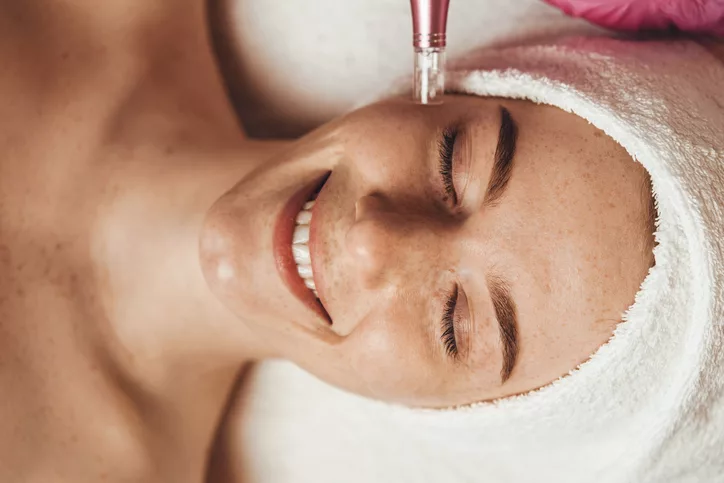We live in a golden age of in-office aesthetic treatments, and that can be both a blessing
and a curse. On the positive side, there’s so much to choose from. On the negative
side, there’s so much to choose from.
Deciding whether to opt for microneedling over laser or chemical peel, however, will be
much easier if you simply read on. Here we’ll do a deep dive on the issue of
microneedling vs. laser, and also lay out the core differences between microneedling
and chemical peel. By the time you’re finished taking this all in, you’ll be Googling
microneedling near me to book an appointment.
First, A Few Microneedling Facts
Also known as collagen induction therapy, microneedling is a minimally invasive skin
tightening procedure that rejuvenates skin through controlled micro injury, encouraging
collagen production, as well as cellular turnover and skin renewal. Throughout the
procedure, a device with tiny needles is used to puncture the skin, which in turn
stimulates collagen production. This results in a tighter, firmer appearance with minimal
or no down-time.
In addition to boosting collagen, microneedling is used to resurface uneven
complexions, and treat a variety of conditions that cause depressions in the skin,
including scarring, enlarged pores, wrinkles and stretch marks.
Although minor results may surface in as few as 24 hours after a professional
microneedling session, they’re typically temporary. More noticeable improvements in
skin’s texture and firmness will appear in three to four weeks, and typically last for
several months.
Now that you’re armed with the “Microneedling 101” basic intel, it’s time to take a look at
the advantage it has over other two super-popular aesthetic treatments, laser and
chemical peel.
What Microneedling Has To Offer Over Laser
In the debate of microneedling vs. laser, it’s clear that although both offer a host of
recognized skin benefits, microneedling may have the edge – for a few reasons.
In broad terms, microneedling and laser seem pretty closely aligned. While
microneedling treatments puncture tiny holes in the skin, laser performs essentially the
same function, except with light energy rather than microscopic perforations. And for
both treatments, the stimulation of collagen is a major goal.
But because it works its magic by delivering heat to the skin, laser is inherently riskier
than microneedling. Temporary darkening of the skin, as well as bruising, are not
uncommon.
There’s also next to no downtime associated with microneedling, while with laser
treatments – particularly the more invasive ablative laser resurfacing, which removes
the surface layer of skin – you can expect up to a week of recovery.
Another key point of difference between the two procedures is cost. Although prices
obviously vary according to where – and with whom – you have your aesthetic
treatments done, microneedling is typically a fraction of the cost of laser, especially the
more aggressive ablative resurfacing referenced earlier.
As a ballpark estimate, while a single microneedling session could cost $250, ablative
laser resurfacing could clock in at closer to $2000. Even the less-invasive, non-ablative
type of laser treatment, which only heats the dermal layers and doesn’t remove the
outer skin layer, can set you back $1500 or so.
Clearly, if your beauty budget is limited, you might want to consider at least testing a
microneedling session first to see if it helps you meet your skin goals before breaking
the bank on a laser treatment.
Microneedling And Chemical Peel: How To Choose
A chemical peel can achieve similar goals to microneedling, including surface
retexturizing, a reduction in acne scarring and the promotion of an overall more youthful
look. While microneedling delivers younger-looking skin by boosting collagen, chemical
peel does so by safely burning away the top layer of skin to reveal the more youthful-
looking skin below.
One big advantage of microneedling over a chemical peel is that it can benefit all skin
tones. A chemical peel, conversely, is best suited for those with lighter complexions. If a
person with a darker complexion receives a chemical peel that is too strong,
hypopigmentation (i.e., uneven lightening) can occur.
If you love the outdoors, you may also want to opt for microneedling over a chemical
peel. Although the recommended aftercare for both treatments includes sun-avoidance,
the time periods differ widely. Post-microneedling, it’s recommended that you stay out of
the sun for a few days. After a chemical peel, that no-sun mandate can stretch to a full
two weeks.
And then there’s the recovery time. After a microneedling session, you can resume your
usual skincare routine within 24 hours. But depending on the type of chemical peel you
receive (they vary in strength from light to deep, depending on the chemical solution
used), recovery can take anywhere from a week for basic healing to months before
redness fully dissipates.
Now that you know about this innovative aesthetic treatment’s core advantages over
laser and chemical peel, have you popped microneedling near me into your search bar
yet? If not, the time is now.


